We have always treated such a strong partner as Daimler strictly before, with the confidence that meaningful analysis of shortcomings only helps it to improve products. But something went wrong in the traditional “producer – critic” system, and this time the press fleet became simply closed for me. Remind me which brand benefited from such a measure?

Meanwhile, readers turn to us with pragmatic questions that need to be answered both with or without the help of representatiму office. For example – what should a person choose if he/she purposefully came for a compact crossover with a three-pointed star? Yes, there are notable players in the segment. But there are also always stubborn clients who are not attracted by Audi, BMW, or even Volvo. Those who need Mercedes by all means. As they say, the best or nothing.
But now it’s not enough to choose the brand only as the model range is splitted. Which Mercedes? We have two classmates in our hands at once: the GLA hatchback and the GLB wagon. The same units are packed differently. First of all, a client chooses a design language. And also a concept: the GLA is more individualistic, while the GLB favors passenger transportation. With the support of a friendly dealer, we also have the opportunity to understand other features.
It’s easier to buy the GLA as the cars are in stock. Here we have a duel of the all-wheel drive 250 4matic modification with a two-liter 224 hp turbo engine and the eight-speed preselective semi-automatic one. However, the GLB 250 sold so poorly that this version was withdrawn from the market. But it will serve the purposes of comparison perfectly. Clients prefer diesel ones.
All other things being equal, the GLB should be a little more expensive. But our GALA Sport is better equipped so the price difference is almost leveled. Any of the test participants will cost about the same amount. In theory, the GLB can be seven-seater, but dealers rarely order a third row for an additional fee. Therefore, the space on the rear seat with lengthwise adjustment and a more spacious trunk can be considered the main practical advantages of the wagon. However, its cabin is not wider, so three passengers on the back seat are just as cramped in the shoulders.
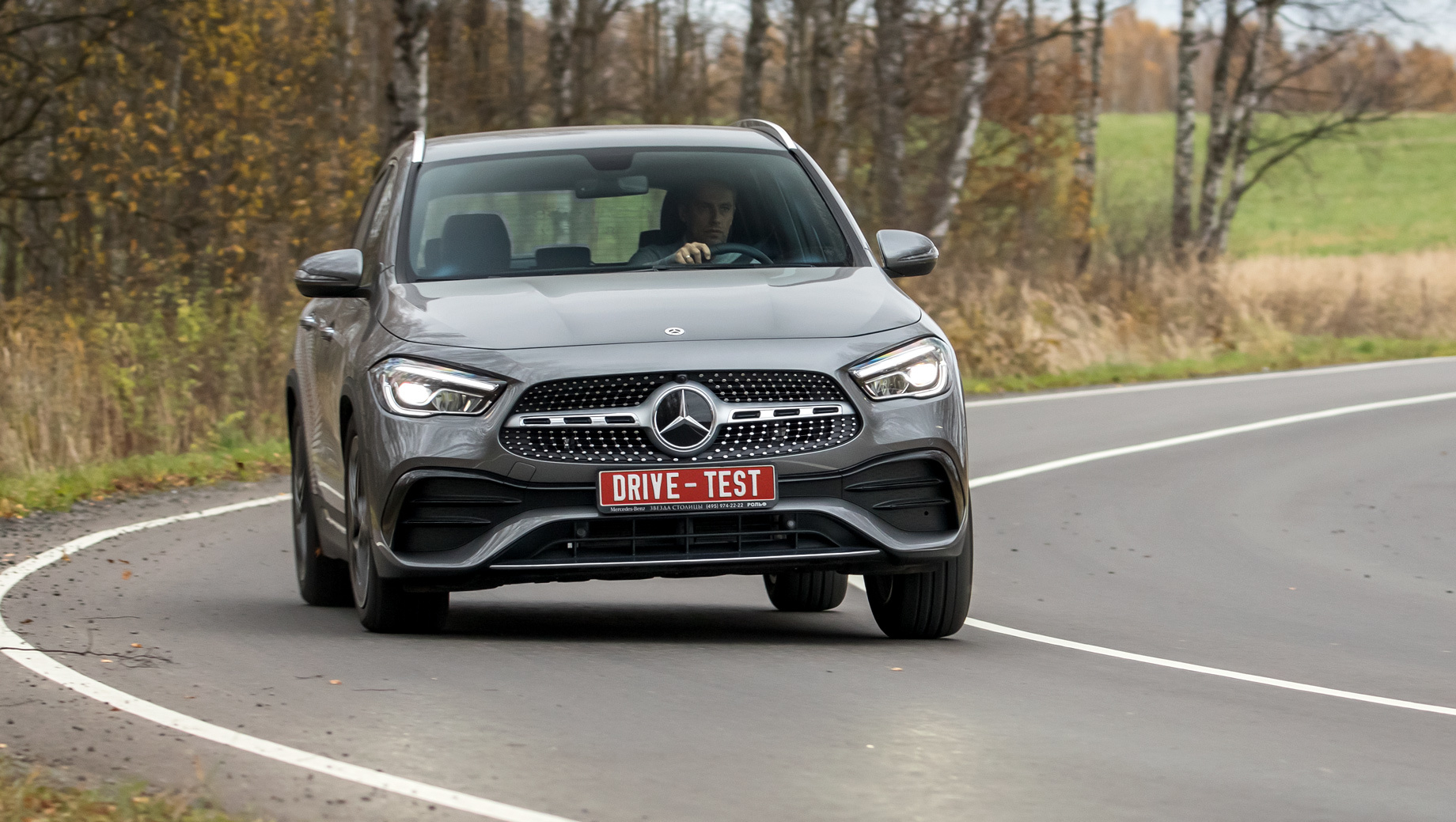
Whichever body option you choose, the impressions behind the wheel are similar, starting with the same fit. At long last, the seats in Mercedes have become more hospitable. Flat chairs are a thing of the past. The hardness of the filler is still high, but the load is distributed noticeably better. Even the GLB, without any Sport in the name, provides tangible lateral support for both the torso and hips. In the GLA, the seat is less malleable and the lower back bolsters are more developed. In addition, it is covered with a friction fleecy fabric imitating suede.
In my opinion, the interiors could be more different. However, judging by the number of cheap solutions, Mercedes can’t afford variability. It is curious that the main contribution to the perceived quality is made by elements unified with older models. These are the steering wheel, climate control units, multimedia system, as well as ventilation cowls. The original parts for this family are made mainly of hard plastic and are unassuming.
The scourge of Mercedes is the driver’s door that doesn’t close on the first try. We haven’t had such a Mercedes in tests for a long time that slammed shut easily. Here we have to bounce in both crossovers too. But developed seals already require high effort. The GLA interior is packed tighter with a door slam: there is a little better protection from external noise. The interior volume of the wagon is larger, and the insulation effect no longer occurs.
While the GLB engine almost doesn’t attract attention to itself, the resonance characteristics of the GLA body and the two-liter “turbo-four” seem to be in worse agreement. The motor is more clearly audible. It vibrates and tinkles slightly when idling. And it buzzes under load. At low revs and accelerations from a low speed, a grain appears in the voice: either the exhaust rattles, or the rumble of the fuel equipment makes itself felt.
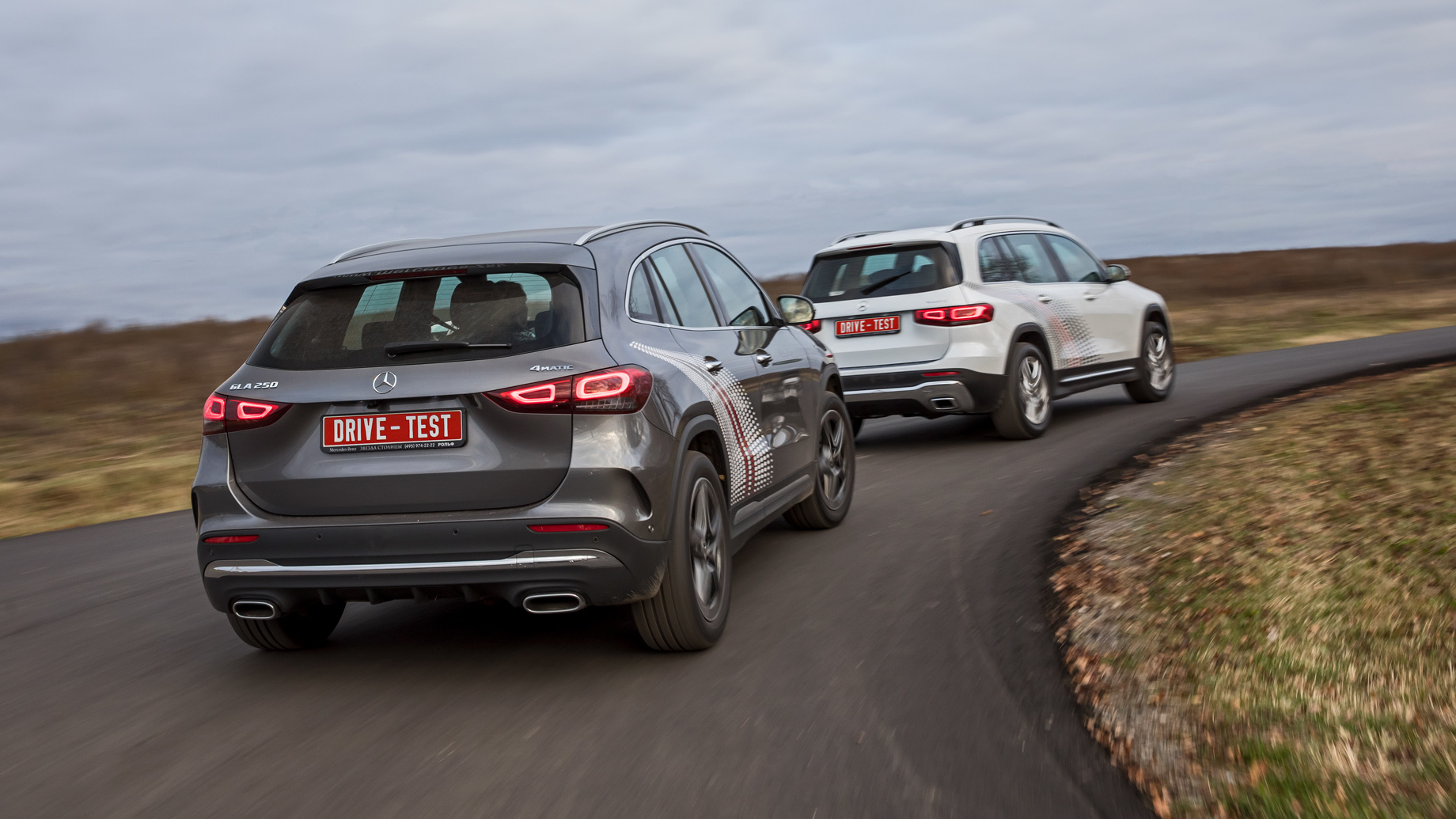
Even with me, the GLA weighs 3530 lbs, so 224 forces is a decent charge. The refueled car with two passengers is ready to gain 60 miles/h in seven seconds (more precisely, in 7.1) according to Racelogic. Approaching the stated 6.7 s is hindered by the hitch of the “robot” while pedal-to-the-metal starting. The second gear doesn’t reach 43 miles/h. The Mercedes goes zero to hundred km/h on the third one, aggressively shifting between clutch engagements with jerks. Acceleration is assertive, although the sound is inexpressive.
In the Comfort, the direct-shift gearbox simulates an automatic one, changing the gears smoothly, slowly, with a clear break in the power flow. From the point of view of the traction control convenience, everything is not bad, but these soft pauses in anticipation of boost are not good. Like any gearbox of this type, the Mercedes “robot” stumbles if you want to accelerate immediately after the throttling back.
The Sport setting also encourages measured movement rather than particularly dynamic. Activation of a kickdown is accompanied by a transmission failure. But the “robot” most often carefully shifts to one or two lower gears with the whistle of an accelerating turbine. The engine is inflated to two and a half to three thousand, but the response to the fuel supply is smoothed out to four. It becomes more or less linear only closer to five, but no one drives like that — it’s noisy.
The wagon is at least 154 lbs heavier, but it is also quite dynamic. It thinks longer at the start and loses a couple of tenths to the hatchback at a test acceleration to 60 miles/h. Reactions to the gas pedal are softer, and upshifts are less noticeable. It seems that the “robot” control program is configured differently.
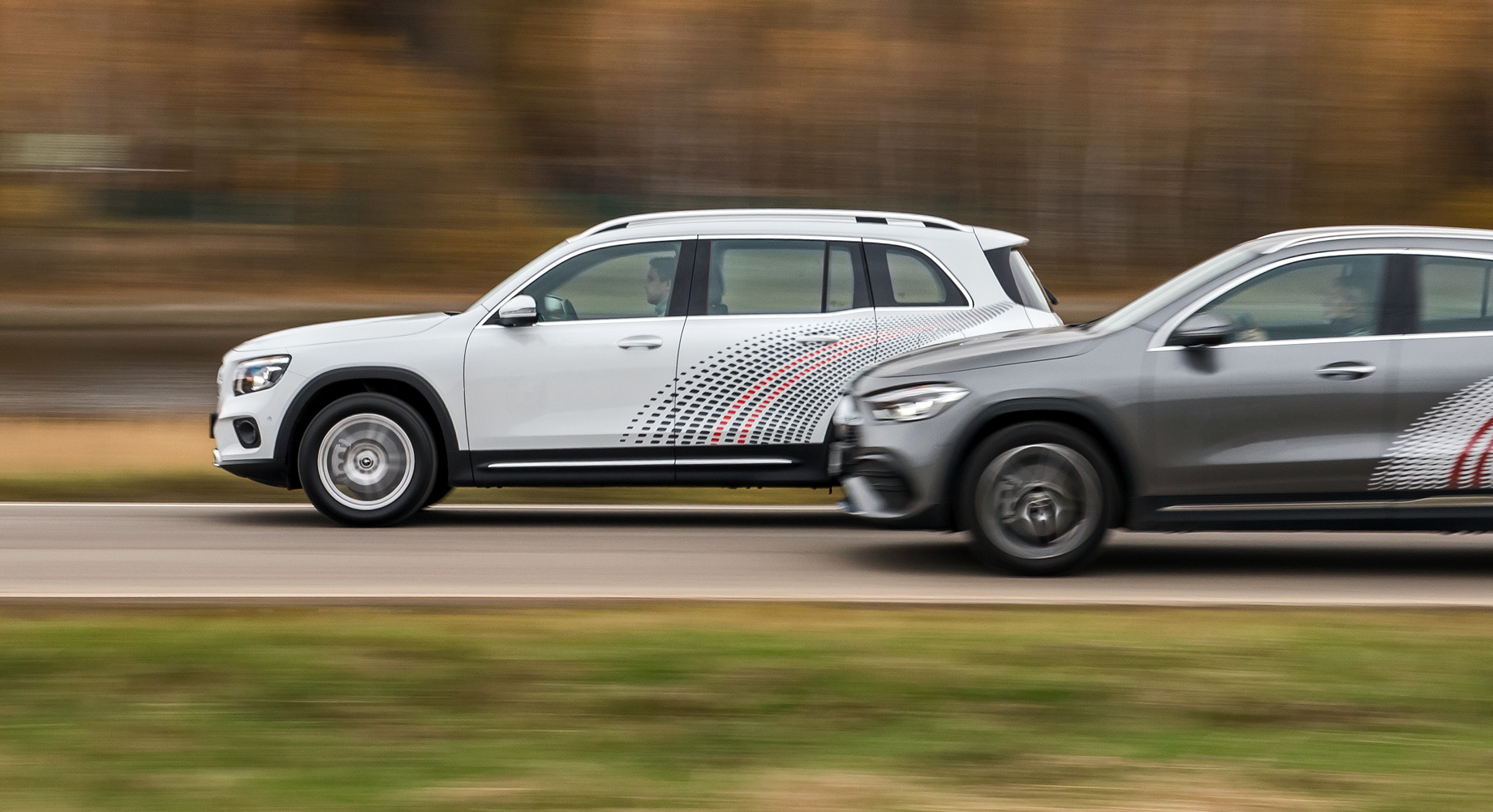
While the programmable Individual mode in the GLA allows honest manual control of the gearbox, the GLB doesn’t have one. Yes, there are steering triggers, but the car always shifts up by itself, and not only from the first to the second gear. And it does it somewhere at six thousand rpm, without bringing the motor to the limit. And the kickdown works freely…
I liked the urban setting of the brakes. The pedal is short-stroke, the drive is moderately sensitive. Slowing down from a high speed raises questions not about efficiency, but about roadholding ability. The short-base GLA sins more by yawing under the influence of a transverse roadway profile.
Both cars are surprisingly well controlled in normal modes. They respond quickly to a change of course, logically roll and don’t freak out on the arc, developing a serious speed. The GLA Sport with a shorter steering wheel and 19-inch Continental Premium Contact 6 SSR tires is expectedly the most driver-friendly. The steering wheel is loaded qualitatively in the zero position; as the steering wheel rotates, the effort logically increases. The latter is always relatively high. But this load is unobtrusive and seems superfluous only in parking modes, especially with fast rotations.
Only the most important information is available to your palms. The rim is almost cleared of high-frequency itching and disturbances on large potholes. Shocks come only from those bumps that get under a heavily loaded wheel – as a signal of the trajectory loss danger. Reaction has no synthetics which was noted, for example, during the GL Coupe test. With its naturalness of response, the GLA power steering resembles successful Volkswagen developments. For example, the Golf GTI Mk6.
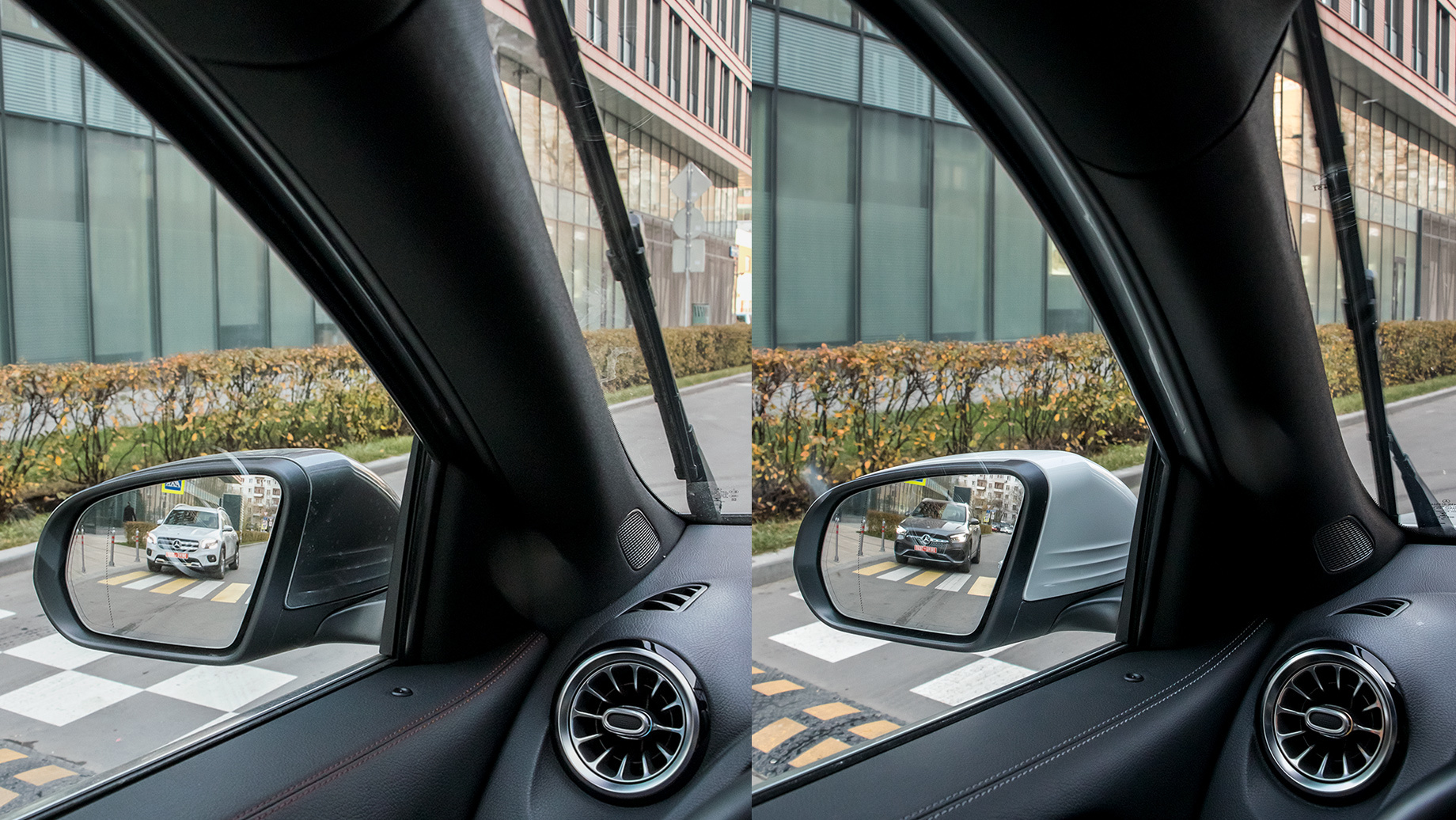
A fly in the ointment is an anti-driver operation of the full-time stabilization system during an emergency avoidance of an obstacle. The roll provokes early activation of ESP: a shock anti-roll-over impulse follows on the outer front wheel. All further maneuver takes place precisely under the dictation of electronics, there is no question of control over the car. Instead of a quick return to its lane, the Mercedes plows on the turned-out wheels, trying to compensate for the nods with brakes. The frequency of braking interventions doesn’t suit the suspension settings — a diagonal swing develops.
The GLB behaves in a similar way, but the rolls are more intense there, and the collar is stricter. But the behavior at the end of the change is more unambiguous. The GLB is good in pre-limit modes: reliable, up a storm. Thanks to the high cross section, Bridgestone Alenza 001 235/55 R18 breaks under longer, slides later, eventually providing the wagon with a larger margin of side grip. However, the steering wheel itself is simpler to the touch, and the drive no longer evokes associations with a hot hatch. A zero position is blurred. The power steering is not bad, and that’s all.
On the steering wheel, a small tremor from the microprofile and vibration of unsprung masses is cut through in places. I would put it down to a more malleable body compared to a hatchback. Taking into account the increased wheelbase, the settings are more daily and designed for a person less experienced in driving, who is not very interested in enjoying it. This Mercedes is more about moving in space. Hence the slight advantage in driving comfort.
Actually, both crossovers should be called rigid. Moving along a road with difficult terrain and a large number of patches, they frankly suffer from suspensions and Run Flat tires clamped in the name of controllability. It’s harder for the GLA’s passengers. The hatchback doesn’t miss a staunching piece, and the hum of low-profile wheels by 43 miles/h squeezes out all other noises from the spectrum, including aerodynamic ones. At the same time, the ride density is sportier due to the smaller amplitude of body movements and greater collectedness on bumps.
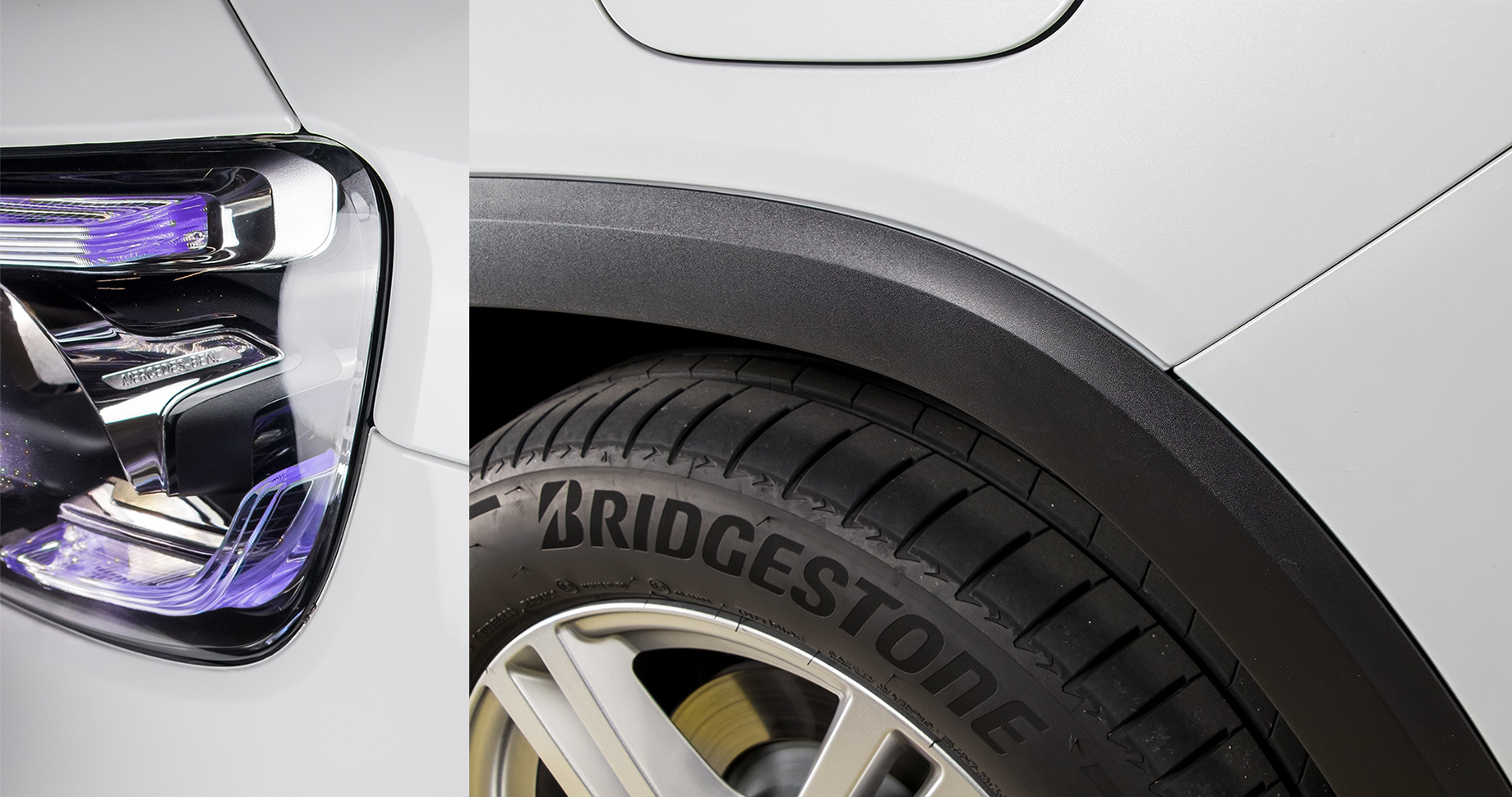
The wagon does everything softer and it is quieter on a flat road. There is no strong tire dominant in the acoustic picture, other sounds are noticeable. The white Mercedes is more tolerant of carelessly paved streets. And especially of speed bumps and large potholes. Although not much more tolerant… The limit of comfort on speed bumps is 18 miles/h. At this speed, the body of the wagon is shaken by powerful pokes. But the GLA with a low comfortable suspension is even more gentle and, when passing the bump at the same 18 miles, transmits painful blows to the cabin.
However, the GLB chassis is flabby and talkative in addition. The wagon voices irregularities in a variety of ways. The palette of overtones is wider, it thumps not only from the back, but also from the front, the body resonates. If the GLB catches some bump on braking, the impact itself is a little softer than in the GLA, but the sound is much more intense, louder and scarier. But crickets already live in the GLB cabin at 1360 miles. In total, there is a feeling of a slightly softened, boiled chassis: the GLB on the move is like a photo of the GLA with a slightly blurred sharpness…
So let it stay with the diesels. Their utilitarian image will help to come to terms with the rustic habits of the GLB. But even being filled with diesel fuel, the wagon with a low level of driving comfort will be appreciated primarily by young buyers. Not to mention the frankly driver’s GLA. Now there are many cars that only look younger, but on the move — retirees. Ours are just genuinely young, not boring at all and perfectly suited for the role of the first Mercedes in life. It’s just that the GLB is designed for a less picky client.
They have the most important property — character. To one degree or another, the majority of Benzes that I have met recently are original. But compact crossovers exceed expectations, which, alas, is atypical for the brand today. They drive more interestingly than you might think. However, I repeat, only the middle-aged audience is able to forgive our heroes for their rigidity and noise for mischief. I didn’t appreciate the emphasis on multimedia: integration with the iPhone is still not seamless. The MBUX system from time to time rejects even those gadgets that are connected by wire…

Previously, it was more interesting to test large Mercedes, now they are increasingly irritating due to the mismatch of positioning and quality. In mass segments, on the contrary, products become more interesting. In addition, the brand is present there for a relatively short time, the price of the error is lower, you can count on leniency. Almost a quarter of a century after the creation of the A-Class, the brand’s image center of gravity, in my opinion, is shifting lower along the pathos axis.
I feel it’s time to rebuild the Mercedes evaluation system. Inexpensive leatherette, an abundance of hard plastic, assembly flaws, and average driving comfort become a common place. You can be indignant from time to time that this doesn’t fit with traditional ideas about the brand. And you can reset to zero. If the trend is really set by Mercedes in cheap segments, if the brand is now developing from the bottom up, then the disadvantages and obvious savings in high classes no longer seem so critical.
This is a translation. You can read the original here: https://www.drive.ru/test-drive/mercedes/5fa17586ec05c4b402000140.html

Published July 21, 2022 • 14m to read



